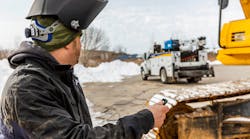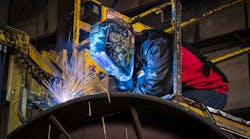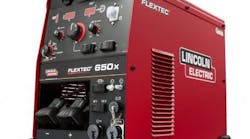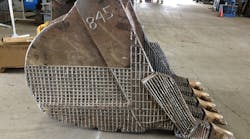Vision protection and protection from heat and electricity, or the arc itself, are obvious precautions for welding. Less obvious is how to prevent exposure to the fumes and gases inherent with many welding projects—and keeping the shop door open for ventilation isn’t always enough.
This is particularly true in hardfacing, work with stainless steel, and other arc welding projects that may feature high arc-on time.
Hardfacing also involves heavier flux-cored wire. “Hardfacing is an application that has higher fume-generation rates than just joining two pieces of metal together,” says Allan Hilbert, product manager for Filtair equipment at Miller Electric. “When you’re doing overlays and rebuilding surfaces on larger pieces of earthmoving equipment, there’s a lot of welding at any given time. And during that time a worker could be overexposed very easily.”
What’s in welding fumes?
The most common compounds in arc welding fume mild steel are iron, manganese, and silicon, although other compounds in the electrode or base metal may be in the welding fume.
Fumes from the use of stainless steel and hardfacing products are likely to contain chromium or nickel, which have their own potential health effects, such as asthma. Also, some forms of the two metals have been known or suspected to cause lung cancer in nonwelding processes, according to information published by Lincoln Electric.
Overexposure to manganese may affect the central nervous system, resulting in irreversible coordination problems, difficulty speaking, and tremors in the arms and legs. There’s also possible overexposure to zinc from welding on galvanized steel that can cause “fume fever,” featuring symptoms that mimic the common flu.
In addition, pay attention to the surface being welded. If a base metal that’s plated or painted cannot be cleaned before welding, the composition of the coating should be evaluated.
There are also the shielding gases used in arc welding. Most of the shielding gases used in arc welding—argon, helium and carbon dioxide—are nontoxic, but they can displace oxygen in breathing air, causing dizziness, unconsciousness and possible death. Carbon monoxide can also be present and pose a hazard if levels are excessive.
OSHA has published a ceiling limit definition regarding how much fume it takes to impact a welder:
“Ceiling is the employee’s exposure which shall not be exceeded during any part of the work day. If instantaneous monitoring is not feasible, then the ceiling shall be assessed as a 15-minute time-weighted average exposure which shall not be exceeded at any time over a working day.”
If a welder feels symptoms of being overexposed, he or she should stop welding and go outdoors for fresh air immediately. If they continue to feel the symptoms, consult a doctor. Back in the shop, be sure the supervisor and any co-workers are aware of the situation and can avoid the hazard. Suspend welding until the situation is resolved.
Measurement and prevention
A welder’s exposure can only be determined by taking a sample of the welder’s breathing air during the workday, essential when hardfacing, welding with stainless steel, or with other special ventilation products.
The two most common exposure limits are established by OSHA in the form of permissible exposure limits or PEL and by the ACGIH in the form of Threshold Limit Values or TLV.
The best way to attack potential problems with welding fumes, according to Hilbert, is to enact OSHA guidelines known as the Hierarchy of Controls. The first two steps deal with changes to the workplace; the latter two require worker participation.
A first step in the Hierarchy is establishing work practice controls for fume reduction, which can include a process or material change, and substitution, eliminating the problem before it can happen.
“This could mean changing consumables away from heavier wire,” Hilbert says. “Take a close look at your process and what you’re using; there may be another way to accomplish your goal with less fume generation.”
Another example would be shifting from stick welding to MIG welding with a solid or metal-cored wire, or using low-manganese filler materials.
The next step in the Hierarchy deals with engineering controls, or physical changes to the workplace. These would include isolation, or ventilation, perhaps enclosing the welding process, capturing material at the source (local exhaust ventilation), and/or ambient collection.
Types of ventilation for welding
“Ventilation is the most common precaution,” Hilbert says. “There are a number of ways to achieve this.”
Keep fumes and gases from the breathing zone and general area using natural or mechanical ventilation, fixed/moveable exhaust hoods, or exhaust at the arc.
Fume extraction guns are another type of source capture. In the past, these guns have been heavy and somewhat unwieldy, but now there are redesigned guns that come close to the weight, handle size and reliability of traditional MIG guns.
There’s also something more basic. Teach workers to keep fumes and gases from the breathing zone by keeping their heads out of the fumes.
“There are some companies that have gone to vision tests to make sure their welders could see well, because guys had their heads too close to the weld,” Hilbert says.
Welders can also change their body position so that airflow moves from back to front. Air movement in the work area should be designed to push fumes away from the breathing zone, as well.
Finally, there is personal protection equipment (PPE) and respiratory protection.
If ventilation can’t be provided, it may be necessary to wear a NIOSH-approved respirator. OSHA requires that engineering and workplace controls be installed first, and if the controls alone do not keep exposures below applicable limits, use respirators.
This step includes implementing respiratory protection such as disposable masks, half masks, powered air- purifying respirators, or supplied-air respirators.
Respirators: the last frontier
Respirators should be used if engineering controls are not feasible or do not reduce fume levels enough, or in maintenance or emergency situations. Whenever respirator use is either mandatory or voluntary, companies must establish and maintain a written respiratory protection program as stated by OSHA 29 CFR 1910.134.
Each type of respirator is given an assigned protection factor (APF), which is the level of protection it will provide when used properly, in conjunction with a written respiratory protection program. Companies must consider the respirator’s APF, air sampling results within the facility, and OSHA’s PELs for those contaminants in the environment to determine which respirator is suitable.
To get the most out of the respiratory protection, it is also important to ensure each employee has selected a respirator that provides a comfortable fit and does not negatively impact productivity. Respirator inspection is an important step that can help ensure the welding operator is fully protected. Train employees on proper inspection procedures before any respirator is used. This information can be found in the user instructions.
Miller’s website stresses that employee training also should cover topics including proper selection of respirators; the consequences of improper fit, usage or maintenance; proper maintenance and storage procedures; and how to use respirators in emergency situations. Having proper documentation when respirators are used also is a critical part of maintaining OSHA compliance. Requirements vary between mandatory and voluntary respirator use, though both do require a written respiratory protection program.
The written program must include information on respirator selection; medical evaluations; fit testing for tight-fitting respirators; use in routine and emergency situations; established schedules for cleaning; procedures to ensure air quality and flow for atmosphere-supplying respirators; employee training; and evaluation of the respiratory program.





